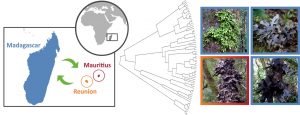Simon A., B. Goffinet, N. Magain & E. Sérusiaux. 2018. High diversity, high insular endemism and recent origin in the lichen genus Sticta (lichenized Ascomycota, Peltigerales) in Madagascar and the Mascarene archipelago. Molecular Phylogenetics and Evolution 122: 15–28. pdf

Abstract reads: Lichen biodiversity and its generative evolutionary processes are practically unknown in the MIOI1 biodiversity hotspot (including Madagascar and the neighboring Mascarene archipelago, formed by Mauritius, Réunion and Rodrigues). We sought to test the hypothesis that lichenized fungi in this region have undergone a rapid radiation, following a single colonization event, giving rise to narrow endemics, as is characteristic of other lineages of plants. We extensively sampled specimens of the lichen genus Sticta in the Mascarene archipelago (mainly Réunion) and in Madagascar, mainly in the northern range (Amber Mt and Marojejy Mt) and produced the fungal ITS barcode sequence for 148 thalli. We further produced a four-loci data matrix for 68 of them, representing the diversity and geographical distribution of ITS haplotypes. We reconstructed the phylogenetic relationships within this group, established species boundaries with morphological context, and estimated the date of the most recent common ancestor. Our inferences resolve a robust clade comprising 31 endemic species of Sticta that arose from the diversification following a single recent (c. 11 Mya) colonization event. All but three species have a very restricted range, endemic to either the Mascarene archipelago or a single massif in Madagascar. The first genus of lichens to be studied with molecular data in this region underwent a recent radiation, exhibits micro-endemism, and thus exemplifies the biodiversity characteristics found in other taxa in Madagascar and the Mascarenes.